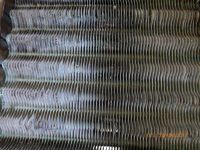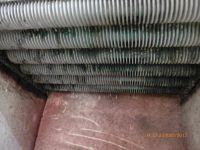Hello all,
I have a problem with the Immergas combi oven, which is two years old and I am looking for advice. The furnace was assembled by the installer, and had acceptance after assembly.
Every six months the oven needs cleaning. A green-white precipitate regularly forms on the heat exchanger (it seems to be the correct name). The effect is always the same, i.e. the first symptoms of this phenomenon are ash particles appearing under the furnace. Then, but only after the evening baths, i.e. when the stove works with increased power (heating alone does not cause such effects), the carbon monoxide sensor begins to activate. After a few more days, in the same circumstances, the stench of flue gas begins to feel, and after a few more days, the stove begins not to heat up the domestic water.
After removing it, you can find a lot of ash inside, which I believe burns on the burners and hence the smell of exhaust gases and activation of the carbon monoxide sensor. It is necessary to clean the heat exchanger, which is clogged with this ash and sediment, which probably causes reduced heating efficiency, and after cleaning it is calm for half a year, after which the situation repeats for the fourth time ...
Can anyone give you a hint what could be the reason for this?
I would add that earlier in the same place and the same installation was installed an old gas furnace, still with a "candle", which was several years old and there were no such problems.
Thank you in advance for your help.
I have a problem with the Immergas combi oven, which is two years old and I am looking for advice. The furnace was assembled by the installer, and had acceptance after assembly.
Every six months the oven needs cleaning. A green-white precipitate regularly forms on the heat exchanger (it seems to be the correct name). The effect is always the same, i.e. the first symptoms of this phenomenon are ash particles appearing under the furnace. Then, but only after the evening baths, i.e. when the stove works with increased power (heating alone does not cause such effects), the carbon monoxide sensor begins to activate. After a few more days, in the same circumstances, the stench of flue gas begins to feel, and after a few more days, the stove begins not to heat up the domestic water.
After removing it, you can find a lot of ash inside, which I believe burns on the burners and hence the smell of exhaust gases and activation of the carbon monoxide sensor. It is necessary to clean the heat exchanger, which is clogged with this ash and sediment, which probably causes reduced heating efficiency, and after cleaning it is calm for half a year, after which the situation repeats for the fourth time ...
Can anyone give you a hint what could be the reason for this?
I would add that earlier in the same place and the same installation was installed an old gas furnace, still with a "candle", which was several years old and there were no such problems.
Thank you in advance for your help.





